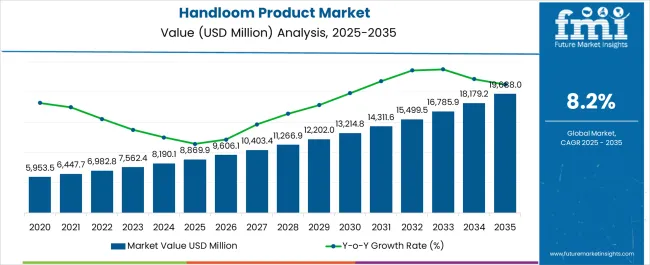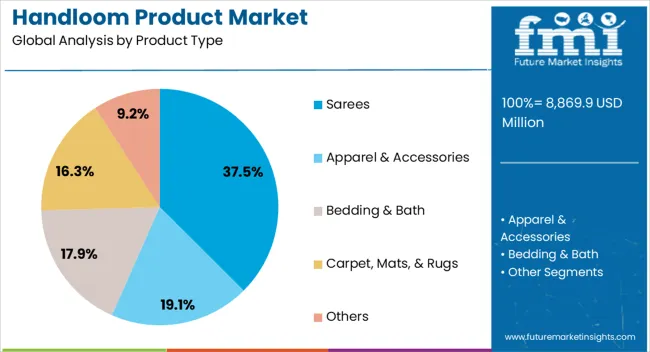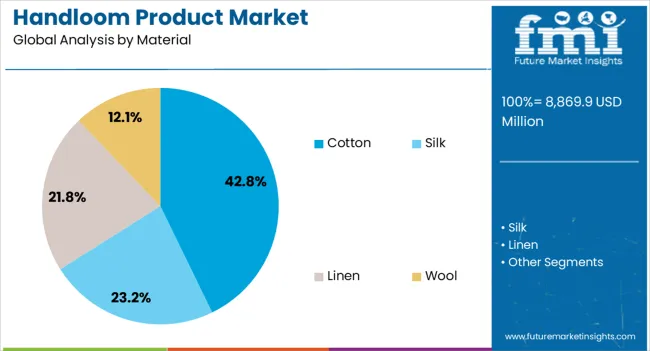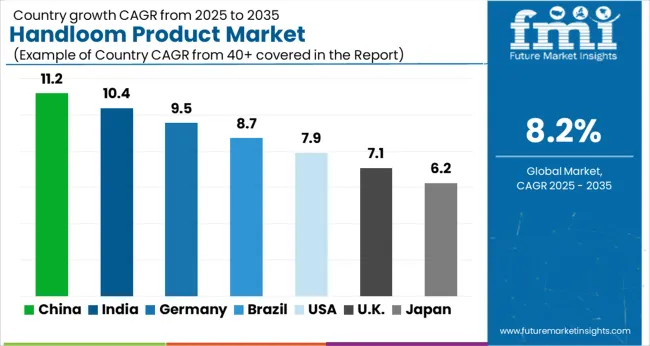The Handloom Product Market is estimated to be valued at USD 8869.9 million in 2025 and is projected to reach USD 19688.0 million by 2035, registering a compound annual growth rate (CAGR) of 8.2% over the forecast period.

| Metric | Value |
|---|---|
| Handloom Product Market Estimated Value in (2025 E) | USD 8869.9 million |
| Handloom Product Market Forecast Value in (2035 F) | USD 19688.0 million |
| Forecast CAGR (2025 to 2035) | 8.2% |
The handloom product market is expanding steadily, supported by rising consumer appreciation for traditional craftsmanship, sustainable production methods, and unique textile designs. Increased demand for eco-friendly and culturally significant products has reinforced the role of handloom goods in both domestic and international markets.
The sector benefits from government support programs, artisan empowerment initiatives, and global awareness campaigns that highlight the value of handmade textiles. Current growth is also being shaped by the integration of e-commerce platforms, which has enhanced market access for small-scale weavers and extended customer reach across urban and international buyers.
Future prospects are strengthened by evolving lifestyle preferences toward slow fashion and heritage textiles, aligning with premium and ethical consumption trends. The combination of cultural authenticity, sustainability, and rising consumer willingness to invest in handmade products positions the handloom sector for sustained expansion.

The sarees segment dominates the product type category with approximately 37.50% share, reflecting its status as the most significant handloom item in both domestic consumption and export markets. This leadership is reinforced by the cultural and traditional significance of sarees, which remain an essential part of wardrobes in many regions.
The segment benefits from strong demand for region-specific varieties such as Banarasi, Kanjeevaram, and Pochampally, each valued for its craftsmanship and heritage. Artisans continue to innovate with contemporary designs, ensuring relevance among younger consumers while maintaining authenticity.
E-commerce platforms have amplified reach, enabling direct-to-consumer models that bypass traditional distribution barriers. With global markets increasingly embracing cultural textiles, the sarees segment is expected to sustain its prominence as a central driver of handloom product growth.

The cotton segment leads the material category with approximately 42.80% share, supported by its widespread availability, comfort, and adaptability to various handloom techniques. Cotton’s breathable and durable properties make it a preferred choice for daily wear and seasonal clothing across different geographies. The segment is further strengthened by consumer inclination toward natural and eco-friendly fabrics, aligning with sustainability trends.
Cotton handloom products are cost-competitive, ensuring accessibility while still retaining artisanal value. Regional clusters specializing in cotton weaving have benefited from both domestic and export demand, with value addition through dyeing and finishing processes.
The material’s versatility across product types, from sarees to home textiles, ensures sustained relevance. With ongoing demand for eco-conscious fabrics, the cotton segment is projected to retain its dominant share in the forecast period.
The market for handloom products relies heavily on changing consumer preferences, such as a growing interest in sustainable and ethically produced goods. Various other factors, such as the economic condition and the financial situation of the people, also decide the fate of that market. Besides this, government policies also influence the market growth for handloom products.
The handloom product market has gone through a series of ups and downs in the past few years. During the pandemic, the world faced sudden shutdowns, and the market experienced an exponential plunge due to decreased consumer demand as people started spending less on non-essential commodities. The lockdown also meant reduced production capabilities coupled with disrupted supply chains.
Post-pandemic, the market began to pick some pace due to the increased digital adoption. The pandemic has already heightened the awareness about sustainability. This led to an increased demand for these garments in the international marketplace. With the opening of economies all around the world, the market started proliferating and has now reached a level of stability.
| Attributes | Key Statistics |
|---|---|
| Market Value (2020) | USD 6,237.1 million |
| Market Value (2025) | USD 7,697.4 million |
| Estimated Growth (2020 to 2025) | 5.40% |
The handloom product market is anticipated to surpass a global valuation of USD 18,179.1 million by the year 2035, with a growth rate of 8.30%. While the market is expected to experience substantial growth, several restraining factors could adversely affect its development:
In the past few years, there has been a noticeable push toward sustainable products in the general population all over the world. In countries like India, Sri Lanka, Nepal, etc., where sarees are essential in women’s wardrobes, it is observed that there is a considerable demand for handwoven sarees. This demand can be attributed to the familiarity and long tradition of handmade sarees since the beginning of the time.
| Attributes | Details |
|---|---|
| Product Type | Sarees |
| Market Share | 35.20% |
Based on product type, sarees dominate the global market for handloom products with a whopping share of 35.20%. Due to social media and short video platforms, handmade sarees are also finding their place in the younger demographic. These individuals are drawn to the sustainability and long durability of sarees. Besides this, fashion designers and influencers are also playing a pivotal role in showcasing handloom sarees in diverse and innovative ways, thus contributing to the market's overall expansion.
Handloom products are generally popular in countries like India, China, and other ASEAN countries. These economies fall under the geographical belt, where the temperature is usually high throughout the year. Cotton clothes are best suited for this climatic condition as they allow breathability, softness, and comfort. Handloom products manufacturers have responded to this demand by curating products like sarees, shirts, and other wearables from cotton.
| Attributes | Details |
|---|---|
| Material Type | Cotton |
| Market share | 36.70% |
Based on material type, handloom products made from cotton dominate the global market with a remarkable share of 36.70%. The demand for cotton handloom products is also increasing in these areas due to their affordability and accessibility. Cotton is available everywhere in the world, making it a perfect choice for a diverse consumer base.

The section analyzes the handloom product market by countries, including China, India, the United States, Germany, and Australia. The table presents the CAGR for each country, indicating the expected market growth in that country through 2035.
India is one of the leading countries in this market. The India handloom product market is anticipated to retain its dominance by progressing at an annual growth rate of 11.10% till 2035.
Indians have been wearing handloom products since ancient times. This familiarity has driven a substantial demand for handloom products, especially sarees and dhotis, in the Indian general population. Besides this, cotton is available in abundance in the Deccan plateau region, enabling small-sized manufacturers to procure raw materials at an affordable cost. This cuts down the production cost, leaving a great scope for profits.
Australia is the leading market for handloom products outside Asia. Over the next ten years, Australia’s demand for handloom products is projected to rise at a 9.50% CAGR.
More than 90 percent of the population in Australia resides in the coastal areas. The climatic conditions in these areas constitute humid weather and warm currents. In such a scenario, people prefer handloom clothes that offer maximum breathability and comfort. This is the reason why handloom products, especially those made of cotton for leisure, are gaining more popularity in the Australian continent.
China is another Asian country in the market. Over the next ten years, the demand for handloom products in China is projected to rise at an 8.40% CAGR.
With the rising disposable incomes of the Chinese middle class, more consumers can afford luxury clothing items. This has a significant impact not just on the domestic market but also on the international marketplace. Moreover, Chinese consumers often look toward global fashion trends, and since sustainable clothing is an ongoing trend, the demand for handloom products is touching the skies in the country.

In the European region, Germany leads the market for handloom products. The market in Germany is poised to showcase a 7.60% advancement per year from 2025 to 2035.
Germany has a strong cultural appreciation for craftsmanship and high-quality products. Handloom products, with their intricate weaving techniques and unique designs, have gained tremendous traction in the German general population. Not only this, ethical consumerism, where consumers prioritize products that are produced under fair labor conditions, is also trending in Germany.
The United States handloom product market is anticipated to register a CAGR of 5.90% through 2035.
Influencers in the United States are the promoters of handloom products. These influencers, with millions of followers, are collaborating with manufacturers in and around the North American region.

The market for handloom products is filled with players like FabIndia, Khadi and Village Industries Commision, Mungo Design, Looms of Ladakh, etc. These players hold a significant part of the overall handloom product market valuation. Market players are inclined to invest in research and development to increase the affordability, sustainability, and accessibility of their products. There is a presence of smaller companies, too, in the market. These companies bring niche or specialized products to the market, catering to specific consumer needs or preferences.
Recent Developments
The global handloom product market is estimated to be valued at USD 8,869.9 million in 2025.
The market size for the handloom product market is projected to reach USD 19,688.0 million by 2035.
The handloom product market is expected to grow at a 8.2% CAGR between 2025 and 2035.
The key product types in handloom product market are sarees, apparel & accessories, bedding & bath, carpet, mats, & rugs and others.
In terms of material, cotton segment to command 42.8% share in the handloom product market in 2025.






Full Research Suite comprises of:
Market outlook & trends analysis
Interviews & case studies
Strategic recommendations
Vendor profiles & capabilities analysis
5-year forecasts
8 regions and 60+ country-level data splits
Market segment data splits
12 months of continuous data updates
DELIVERED AS:
PDF EXCEL ONLINE
Product Life-Cycle Management (PLM) IT Market Size and Share Forecast Outlook 2025 to 2035
Product Analytics Software Market Size and Share Forecast Outlook 2025 to 2035
Products from Food Waste Industry Analysis in Korea Size, Share and Forecast Outlook 2025 to 2035
Products from Food Waste in Japan - Size, Share, and Forecast Outlook 2025 to 2035
Production Logistics Market Size and Share Forecast Outlook 2025 to 2035
Products from Food Waste Market Analysis - Size, Growth, and Forecast 2025 to 2035
Product Design Verification And Validation Solution Market Size and Share Forecast Outlook 2025 to 2035
Production Printer Market - Growth, Demand & Forecast 2025 to 2035
Product Information Management Market Growth – Trends & Forecast 2024-2034
Product Dispensing Machinery Market
Product Cost Management Market
CBD Product Packaging Market Size and Share Forecast Outlook 2025 to 2035
USA Products from Food Waste Market Growth – Trends, Demand & Outlook 2025-2035
Competitive Overview of CBD Product Packaging Market Share
Soda Production Machine Market Size and Share Forecast Outlook 2025 to 2035
Competitive Overview of Date Product Market Share
Teff Products Market
Dairy Product Packaging Market Size and Share Forecast Outlook 2025 to 2035
Glass Product Market Size and Share Forecast Outlook 2025 to 2035
Early Production Facility Market Size and Share Forecast Outlook 2025 to 2035

Thank you!
You will receive an email from our Business Development Manager. Please be sure to check your SPAM/JUNK folder too.
Chat With
MaRIA